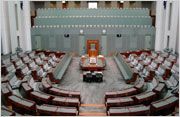Archived News for Research Sector Professionals
ANU scientists have successfully bent light beams around an object on a two dimensional metal surface, opening the door to faster and cheaper computer chips working with light.
The international team, including three members from the Research School of Physics and Engineering at ANU, have successfully demonstrated that a tiny beam of light on a flat surface can be bent around an obstacle, and course-correct itself on the other side of that obstacle. It’s the world’s first two-dimensional demonstration of so-called ‘Airy beams’. Their paper on the subject will be published in this month’s Physical Review Letters.
“Students in science class learn that light rays travel along straight trajectories and that it can’t go around corners,” said ANU team member Professor Yuri Kivshar.
MDBA supports cotton research centre
The Murray-Darling Basin Authority (MDBA) has announced its support for the creation of a co-operative research centre (CRC) for Cotton Regions.
Australian Laureate Fellows for 2011 announced
Australian Laureate Fellowships worth over $44 million have been awarded to 17 Australian and overseas researchers.
Call for applications for WA Research and Innovation grants
The Western Australian Government has called for expressions of interest in a suite of new programs under the Research and Innovation Fund.
Wind tunnel launched at University of Adelaide
South Australia's first industrial-scale wind tunnel has been launched by the University of Adelaide.
Deakin Uni project seeks partners for new concept in city driving
Engineers at Deakin University are looking for research, manufacturing and funding partners to further develop a new car design that combines the best features of a car and a motorbike.
Researchers call for large-scale restoration of native vegetation to counter climate change impacts
Native vegetation must be restored to protect Australia’s unique ecosystems from the impacts of climate change, according to scientists from the Australian National University.
New Centre for Social Science Innovation for Queensland
A new Queensland Centre for Social Science Innovation (QCSSI) is to be established with funding of $5 million from the Queensland Government over the next five years matched collectively by The University of Queensland, Queensland University of Technology, Griffith University, James Cook University and the Central Queensland University.
Space project to boost weather and climate change monitoring
The Federal Government has announced a ‘world-class’ space research project which aims to improve weather forecasting and understanding of climate change, to be funded by the Australian Space Research Program (ASRP).
Australian to develop international mining research centre
CSIRO’s Dr Neal Wai Poi will lead the development of a major new international mining and mineral processing research centre based in Santiago, Chile.
CSIRO deploys deep-ocean sentinels
The CSIRO have deployed three deep-ocean moorings that will be used to observe and measure change in currents linking the Pacific and Indian Oceans through the Indonesia Archipelago, which is considered a key factor in influencing Australia’s climate.
Australia-China research relations strengthened
Federal Innovation Minister Senator Kim Carr and China’s Minister of Science and Technology Dr Wan Gang have formalised a new Australia-China Science and Research Fund in a Memorandum of Understanding (MoU) signed in Shanghai.
New funding for plastic solar cells
The Australian Federal and Victorian State Governments are jointly providing funding of $3.5 million to further develop plastic solar cells currently being produced in Victoria.
NSW Committee appointed to develop Health and Medical Research Strategy
The NSW Government has appointed a Health and Medical Research Strategic Review Committee to develop a 10-year plan for medical research in the state.
Report examines innovation strengths and weaknesses
The second annual report on innovation in Australia has shown that our performance in the area of research and skills has been above OECD average and our performance in entrepreneurship is one of the best in the world.
Chief Defence Scientist to quit position
The Chief Defence Scientist of the Department of Defence, and the head of the Defence Science and Technology Organisation (DSTO), Professor Robert Clark, will be leaving the position in October at the completion of his three-year tenure.
Tequila plant to help reduce emissions
Large scale farms of the agave plant used to make the drink tequila could be established in Australia's arid inland as a solution to transport fuel problems, a University of Sydney academic has found.
R&D Tax Credit to help small to medium firms
An independent economic analysis of the Federal Government’s Research and Development Tax Credit has verified that the scheme is set to assist small and medium sized firms grow their businesses.
Opinion: Our future in space
By Dr Steven Tsitas and Professor Andrew Dempster of the Australian Centre for Space Engineering Research at UNSW.
$66.5 million for solar research
The Federal Government has announced a $66.5 million grant under the Education Investment Fund (EIF) to fund ‘world-leading’ research that will assist in the construction of one of the largest solar power plants in the world.







